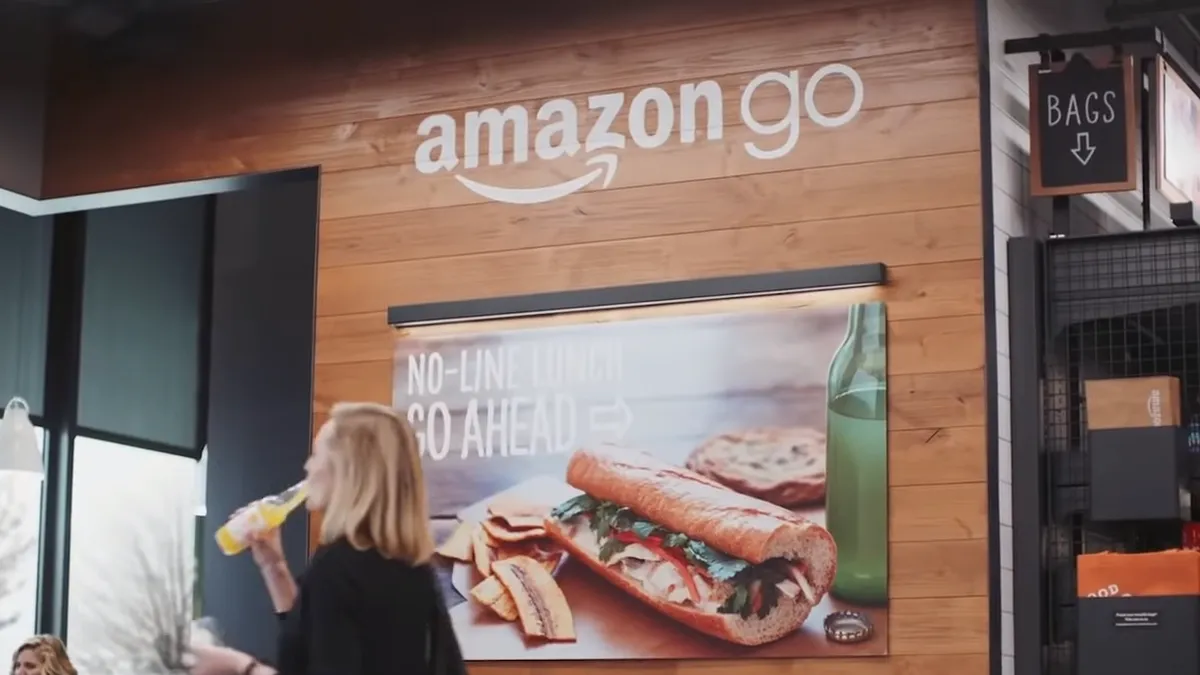Highlights
Opened to the public:
January 2018
Estimated stores in 3 years:
3,000
Outlook:
The cashierless store concept epitomizes a seamless shopping journey and demonstrates how mobile tech can augment in-store experiences for any number of retailers.
Marketers for years have experimented with weaving smartphones into brick-and-mortar retail, but it wasn't until this year that Amazon's cashierless store concept demonstrated how innovative mobile technology can advance a seamless shopping experience. From self-checkout, beacons, "smart shelves" and other high-tech integrations, technology has continued to creep into stores. Juniper Research estimates that cashierless transactions will hit $78 billion by 2022, up from an anticipated $9.8 billion last year. And now, Go's "just walk out" format is upending the entire shopping experience while changing what it means to be truly seamless.
Since Amazon opened to the public its first conveniently compact store in Seattle, a question has loomed around just how big the cashierless concept will become. Will the Go model become the new gold standard for brick-and-mortar retail or will it fizzle once the novelty wears off?
"Amazon Go is going to be everywhere. I don't see how it isn't," Casey Gannon, vice president of marketing at Shopgate told Mobile Marketer. "Most retailers are going to need to look at mobile technology in a way that helps create remarkable in-store experiences but will need to use mobile in very different ways, potentially drawing from some elements of Go."
Racing to the starting line
Amazon Go has come a long way since its January grand opening after a long, delay-ridden jog to the starting line. The concept's early success helped to fuel rapid expansion to Chicago, New York and San Francisco. While the company doesn't provide financial details on Go, people familiar with the matter told Bloomberg that as many as 50 locations could open by the end of next year and another 3,000 by 2021.
The original 1,800-square-foot Amazon Go solves the pain point of standing in line at the checkout — something tech startup Zippin says Americans waste around 37 billion hours a year doing — through a somewhat complex system of mobile and in-store tech. Shoppers scan a smartphone app as they enter and shop like normal, as hundreds of finely calibrated cameras in the ceilings track what's taken off the shelves. The magic of the store is that shoppers can simply leave without having to scan items or visit a cashier. As they exit, their Amazon account is automatically charged for the items in their basket.
Setting a precedent
Some marketers and analysts say that Go's proof of concept is poised to elevate consumers' expectations of such frictionless experiences. By forcing competitors like Walmart and Kroger to pivot on their digital plans and adjust to this new tech, Amazon has set a precedent for the modern shopping journey.
"Amazon Go is going to be everywhere. I don't see how it isn't."

Casey Gannon
VP of marketing, Shopgate
Walmart expanded its Scan & Go go app to 100 additional stores shortly after the first Go store opened to let customers skip the checkout line and instead scan, bag and pay for items directly through their smartphone. Meanwhile, Kroger announced it would beef up its "Scan Bag Go" pilot to 400 stores and add more pre-made meals to boost its convenience-focused offerings. In late October, Sam's Club said it was close to opening a 32,000-square-foot cashierless shop, dwarfing Go's typical size. Though Walmart abandoned Scan & Go in May due to low customer adoption, the chain is now focusing on a mobile point-of-sale system to let employees ring up customers' items anywhere in the store. Tech companies are also hot on Amazon's heels, with Microsoft and startups AiFi, Zippin, Inokyo, Standard Cognition, Skip and Aipology racing to develop cashierless checkouts.
Forecasting a frictionless-retail war
As Walmart discovered this year with its unpopular Scan & Go app, customer adoption of new checkout formats is critical for success. So far, Amazon's "just walk out" concept appears to most strongly resonate with on-the-go consumers. A survey from Shorr Packaging found that 75% of respondents would be interested in shopping at a Go store if one were nearby.
While this type of tech is mostly limited to deep-pocketed retailers like Amazon and Kroger, who can afford the steep implementation price, the competition has already begun to heat up, hinting at a frictionless-retail war ahead as the technology evolves and costs drop. If 2018 was about testing this concept with consumers, 2019 will likely be about proving that Go's technology is worth the investment.
Read More
-
San Francisco gets its first Amazon Go store
By Dan O'Shea • Oct. 23, 2018 -
After Amazon Go's launch, retailers renew focus on how mobile shapes in-store shopping
By Natalie Koltun • April 3, 2018 -
Amazon Go stores threaten the economy, UFCW chief says
By Daphne Howland • Sept. 24, 2018
























